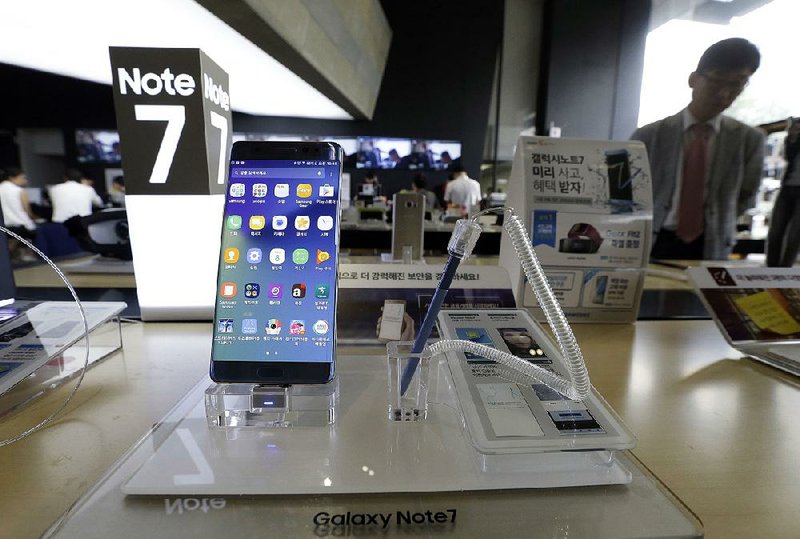SEOUL, South Korea -- Samsung said its recall of 2.5 million Galaxy Note 7 phones after several dozen caught fire and exploded stems from a subtle manufacturing error, but the smartphone-maker drew criticism from analysts suggesting it had skimped on its battery technology.
Announcing the recall Sept. 2, Samsung confirmed dozens of cases in which Note 7 batteries caught fire or exploded, mostly while charging. It plans a software update that will cap battery recharging at 60 percent capacity to help minimize risks of overheating. But it is urging owners to keep the phones turned off until they can get them replaced, beginning Monday.
The Note 7 debuted to good reviews in August thanks to its speed, new software features and -- not least -- the estimated nine hours it would run between charges. But all that power comes at a price: Users began reporting the phones were catching fire or exploding, in one case incinerating the SUV it had been left in.
Aviation authorities in the U.S., Australia and Europe have urged passengers not to use or charge Note 7s while flying and not to put them in checked baggage. On Monday, Canada issued an official recall.
Koh Dong-jin, Samsung's mobile president, said in announcing the recall that an investigation turned up a "tiny error" in the manufacturing process for the faulty batteries in the Note 7s that was difficult to identify. The end of the pouch-shaped battery cell had some flaws that increased the chance of stress or overheating, he explained.
That kind of manufacturing error is unimaginable for top-notch battery makers with adequate quality controls, said Park Chul Wan, a former director of the next generation battery research center at the state-owned Korea Electronics Technology Institute.
Samsung and other experts should search for factors outside the battery cells that could have led to overheating, he said.
"If Koh's argument is right, that makes Samsung SDI a third-rate company," Park said. "But it does not appear to be a simple battery problem."
Time also is a factor in marketing and making the phones.
In 2015, Samsung moved up its unveiling of its new Galaxy Note model to August from September, seeking a leg up on Apple's September iPhone upgrades.
Before the issue of battery explosions emerged, supplies were not keeping pace with demand for the Note 7.
Samsung has not recalled Note 7s sold in China, but the company has refused to say which of its two battery suppliers made the faulty batteries or clarify whose batteries are used in which Note 7 smartphones. The company also refused to comment on South Korean media reports that it has stopped using batteries from Samsung SDI, one of its two suppliers, in the Note 7.
C.W. Chung, an analyst at Nomura Securities in Seoul, cited SDI officials in estimating that about 70 percent of the batteries for the Galaxy Note 7 smartphones came from SDI.
The other 30 percent are thought to have been supplied by Amperex Technology Ltd., a Chinese-based manufacturer that reportedly also is a main supplier of batteries for the iPhone.
Problems with lithium batteries have afflicted everything from laptops to Tesla cars to Boeing's 787 jetliner, though having so many lithium-ion battery fires in a short time is unheard of, Park said.
The batteries are ubiquitous in consumer electronic devices, favored by manufacturers because they are lightweight and pack much more energy into a small space than other power cells.
But storing so much energy in a tiny space, with combustible components separated by ultra-thin walls, makes them susceptible to overheating if exposed to high temperatures, damage or flaws in manufacturing. If the separators fail, a chemical reaction can quickly escalate out of control.
That's what happened with the Note 7, Koh explained.
"The flaw in the manufacturing process resulted in the negative electrodes and the positive electrodes coming together," he told reporters in Seoul.
It is unclear how Samsung failed to discover the battery problem before launching the Note 7. It confirmed delays in shipments for extra quality tests weeks later, in late August, after photos of charred phones began popping up on social media.
South Korean experts suggested Samsung may have been so ambitious with the Note 7's design that it compromised safety.
"There was no choice but to make the separator [between positive and negative anodes] thin because of the battery capacity," said Lee Sang-yong, a professor at Ulsan National Institute of Science and Technology who worked more than a decade at LG Chem, a leading lithium battery maker. Thicker separators can improve safety but will not necessarily prevent all overheating issues, he said.
Doh Chil-Hoon, head of the state-run Korea Electrotechnology Research Institute's battery research division, said that based on the limited information provided by Samsung, he believes the push to increase battery power was part of the problem.
"Even with a small manufacturing mistake, if there had been enough elements to ensure safety, it would not explode," Doh said. "It is a roundabout way of admitting weak safety."
Information for this article was contributed by Brandon Bailey of The Associated Press.
Business on 09/16/2016
